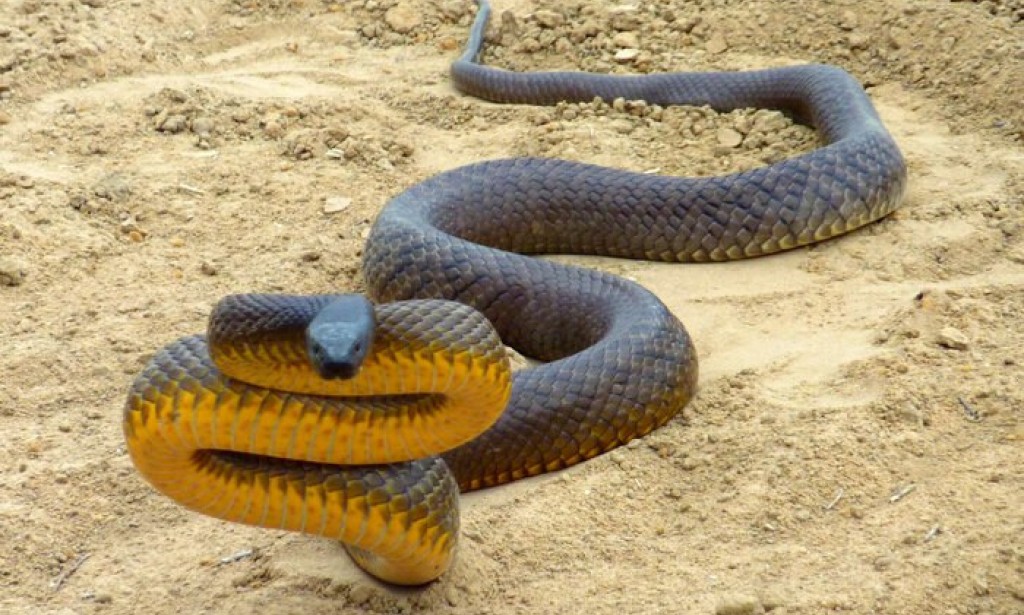10th place. Tiger snake (Notechis scutatus). LD50= 0.194 mg/kg.
Beautifully colored snake of the family Aspidae. In contrast to the previous species - peaceful. Do not attack people just like that. Preys on small rodents, which are killed almost instantly from the injected poison. The "tigress" is native to Australia.
9th place. Tiger snake (Notechis scutatus). LD50= 0.131 mg/kg.
No, that's not a typo. It's just that the population of tiger snakes in Australia is highly fragmented. And the fragments are so isolated that they take on different characteristics and species. This phenomenon is called "morph" in biology, which means "form" of the same species. So the black morph of the tiger snake is considerably more venomous, judging by the lethal dose.
8th place. Nasal Enhydrina (Enhydrina schistosa). LD50=0.1125 mg/kg.
Lives in South and Southeast Asia. Is found along the coast. Excellent swimmer and dive to a depth of 100 m. Can stay underwater for up to five hours. Unusually dangerous and aggressive. Which, however, does not prevent the Chinese from enjoying it.
Seventh place. Laticauda semifasciata. LD50 = 0.111 mg/kg.
Like the tiger snake refers to aspids. Like the enhydrina lives in the sea. Quite large, up to 1.5 m. And quite northern. By the way, one of the two on the list of which can be found in Russia. Sometimes sea kraitfish are spotted in the Peter the Great Bay.
Sixth place. South China multibranch krait (Bungarus multicinctus). LD50= 0.108 mg/kg.
Lives slightly more southerly than its previous counterpart. Slightly smaller and more beautifully colored. Like the previous two beggars, eagerly eaten by the Chinese and Vietnamese.
5th place. Typan (Oxyuranus scutellatus). LD50 = 0.099 mg/kg.
We stepped into the top five. And with it, we began to consider snakes whose venom is sufficient to kill in concentrations of less than one-tenth of a milligram. The typhant is another resident of Australia. In my childhood days, it was mentioned in some program called "In the Animal World" that it was the third most venomous. And I always wondered who the first two were. As a matter of fact, that's what I'm doing now.
The 4th. Perona flipper (Hydrophis peronii). LD50 = 0.079 mg/kg.
The only snake in the genus with crests on its head. Lives in the sea, from the shores of Southeast Asia, in the Gulf of Thailand, to Australia. Feeds on small fish. Viviparous. Hunts on reefs and sandbanks.
3rd. The bicolor pelamid (Hydrophis platura). LD50 = 0.067 mg/kg.
Also belongs to the pinnipeds and is common in the Indian and Pacific Oceans. Occasionally found in Russian waters of the Sea of Japan.
2nd place. Brown reticulated snake (Pseudonaja textilis). LD50 = 0.053 mg/kg.
Occurs also in Australia and New Guinea. Belongs to the genus of false cobras of Gunther. Like the cobra, the snake assumes a threatening S-shaped posture and flattens its neck, but does not form such a full-fledged hood as cobras do. Often found near human habitation, where it is attracted by rodents, and therefore dangerous. Despite the high toxicity of the venom, death occurs in only 10-20% of cases, as defensive bites are small portions of the venom.
1st place. McCoy's Typan (Oxyuranus microlepidotus). LD50 = 0.044 mg/kg.
The only Australian snake that changes color depending on the time of year. Grows up to two and a half meters. At the same time is very secretive and fearful. The venom injected in one bite is enough to kill 289 adult males. (So sucking the wound probably won't work).



You must be logged in to post a comment.